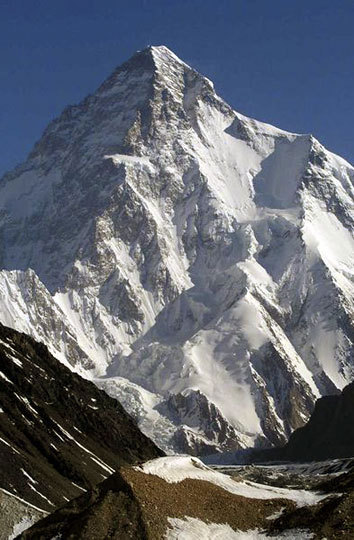Greetings from Islamabad. The recent tragedy on K2 is a most unfortunate incident in which eleven precious lives were lost above 8000m. This has been another deadly incident in the history of K2, one which grieves all of us here in Pakistan. One Serbian and a Pakistani died on the way up, and all of the others died on their return from the summit. Most of them became weak due to exposure, as they were forced to spend the night of August 1, 2008 out in the open above the Bottleneck–higher than 8200m, with temperatures below -25 C wind chill making it even worse.

K2, Karakoram, Pakistan: the site of the August 1, 2008, disaster in which eleven climbers perished in the aftermath of an avalanche on the upper slopes of the peak.
From a climber’s point of view, I think they all made several mistakes: for example, making an agreement on a joint final summit push with over two dozen people at the same time, or depending on others for fixing ropes above 8000m. The worst part was a lack of timely crucial decision making in addition to trying to reach the summit so very late in the day. Although most of them had a sound climbing background, there were some climbers who were lacking the crucial extra energy, experience for survival and technical ability to cope with this kind of situation.
We know that a few survivors are trying to blame some other climbers, local crew and others. They also seem to be throwing responsibility elsewhere, claiming that ropes were fixed much below the Bottleneck on easier ground, and they had to replace them, which made them late in reaching the summit. They also blame some of the high-altitude porters, but it is evident that all the teams are deeply divided on where to throw the blame for various issues. This is unfortunate, and is often the case when tragedies of this magnitude occur; this kind of blame game to me seems unfair. I acknowledge the fact that we humans often find it hard to make accurate decisions when embroiled in such situations and at this altitude we tend to make mistakes. The Sherpas and the high-altitude porters can’t be expected to play the role of fixing the ropes and camps on higher ground on K2. Commercial climbing has no place on K2 like on easier mountains like Broad Peak, G2 or even Everest.
Meanwhile, we have been meeting the returning climbers who were part of the dilemma and were higher up on K2. There are obvious differences on several issues among the many parties on the mountain.
I had a lengthy meeting with Mr. Alberto of Spain, who was first on the summit that day at 3 p.m. It seems the last person who left the summit was around 9:30 p.m. It was suicidal to continue climbing toward the summit of K2 when they had seen the route conditions around the Bottleneck, and had even witnessed people dying earlier in the day. There have been several mentions of people losing their senses during the descent–at night, and out of oxygen.
The Serbian mountaineer Mr. Dren Mandic lost his life when he slipped from the lower icy slope of the Bottleneck. This fatal accident took place around 11:12 a.m. on Friday, August 1 as a much worse omen on a summit day. His body was found fifteen minutes later by his two teammates and one of their Pakistani high-altitude porters. It has been said that the Pakistani climber Jehan Baig was returning due to fatigue and some illness. He also took part in retrieving the body of Dren and suddenly slipped down eastern icy slopes of K2. The Serbian team leader, Mr. Milivoj Erdeljan, issued a statement with further details that can be read on everestnews.com.
This incident was discussed at a high-level meeting held at the Ministry of Tourism. Both Dutch survivors Wilco van Rooijen and Cas van de Gevel, the Korean climbers, their LO Capt. Azim and their Sherpas also were present at this condolence meeting. The Secretary of Tourism will put together a team to conduct a thorough fact-finding investigation consisting of both officials from Ministry of Tourism and the Alpine Club of Pakistan to probe into the drama on K2.
With best regards,
Nazir Sabir